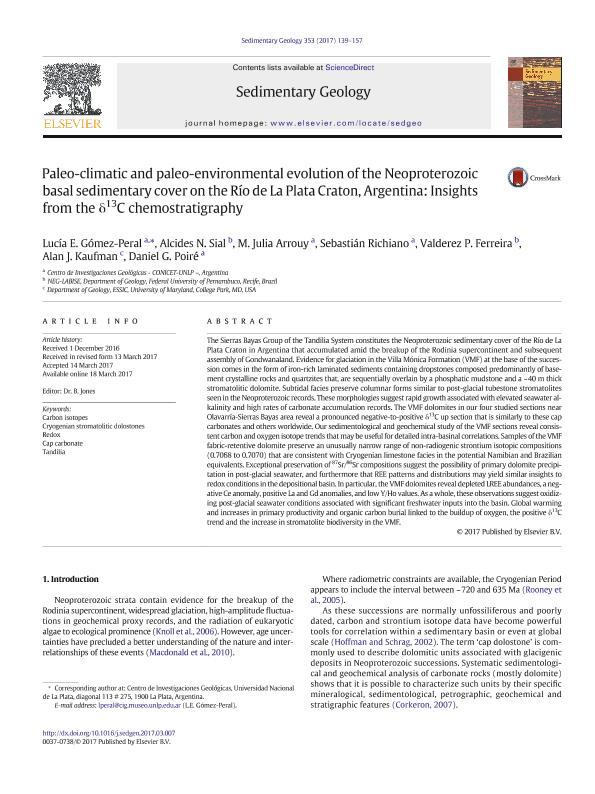Artículo
Paleo-climatic and paleo-environmental evolution of the Neoproterozoic basal sedimentary cover on the Río de La Plata Craton, Argentina: Insights from the δ13C chemostratigraphy
Gómez Peral, Lucia ; Sial, Alcides N.; Arrouy, Maria Julia
; Sial, Alcides N.; Arrouy, Maria Julia ; Richiano, Sebastián Miguel
; Richiano, Sebastián Miguel ; Ferreira, Valderez P.; Kaufman, Alan J.; Poire, Daniel Gustavo
; Ferreira, Valderez P.; Kaufman, Alan J.; Poire, Daniel Gustavo
 ; Sial, Alcides N.; Arrouy, Maria Julia
; Sial, Alcides N.; Arrouy, Maria Julia ; Richiano, Sebastián Miguel
; Richiano, Sebastián Miguel ; Ferreira, Valderez P.; Kaufman, Alan J.; Poire, Daniel Gustavo
; Ferreira, Valderez P.; Kaufman, Alan J.; Poire, Daniel Gustavo
Fecha de publicación:
05/2017
Editorial:
Elsevier Science
Revista:
Sedimentary Geology
ISSN:
0037-0738
Idioma:
Inglés
Tipo de recurso:
Artículo publicado
Clasificación temática:
Resumen
The Sierras Bayas Group of the Tandilia System constitutes the Neoproterozoic sedimentary cover of the Río de La Plata Craton in Argentina that accumulated amid the breakup of the Rodinia supercontinent and subsequent assembly of Gondwanaland. Evidence for glaciation in the Villa Mónica Formation (VMF) at the base of the succession comes in the form of iron-rich laminated sediments containing dropstones composed predominantly of basement crystalline rocks and quartzites that, are sequentially overlain by a phosphatic mudstone and a ~ 40 m thick stromatolitic dolomite. Subtidal facies preserve columnar forms similar to post-glacial tubestone stromatolites seen in the Neoproterozoic records. These morphologies suggest rapid growth associated with elevated seawater alkalinity and high rates of carbonate accumulation records. The VMF dolomites in our four studied sections near Olavarría-Sierras Bayas area reveal a pronounced negative-to-positive δ13C up section that is similarly to these cap carbonates and others worldwide. Our sedimentological and geochemical study of the VMF sections reveal consistent carbon and oxygen isotope trends that may be useful for detailed intra-basinal correlations. Samples of the VMF fabric-retentive dolomite preserve an unusually narrow range of non-radiogenic strontium isotopic compositions (0.7068 to 0.7070) that are consistent with Cryogenian limestone facies in the potential Namibian and Brazilian equivalents. Exceptional preservation of 87Sr/86Sr compositions suggest the possibility of primary dolomite precipitation in post-glacial seawater, and furthermore that REE patterns and distributions may yield similar insights to redox conditions in the depositional basin. In particular, the VMF dolomites reveal depleted LREE abundances, a negative Ce anomaly, positive La and Gd anomalies, and low Y/Ho values. As a whole, these observations suggest oxidizing post-glacial seawater conditions associated with significant freshwater inputs into the basin. Global warming and increases in primary productivity and organic carbon burial linked to the buildup of oxygen, the positive δ13C trend and the increase in stromatolite biodiversity in the VMF.
Archivos asociados
Licencia
Identificadores
Colecciones
Articulos(CIG)
Articulos de CENTRO DE INVEST.GEOLOGICAS (I)
Articulos de CENTRO DE INVEST.GEOLOGICAS (I)
Citación
Gómez Peral, Lucia; Sial, Alcides N.; Arrouy, Maria Julia; Richiano, Sebastián Miguel; Ferreira, Valderez P.; et al.; Paleo-climatic and paleo-environmental evolution of the Neoproterozoic basal sedimentary cover on the Río de La Plata Craton, Argentina: Insights from the δ13C chemostratigraphy; Elsevier Science; Sedimentary Geology; 353; 5-2017; 139-157
Compartir
Altmétricas



